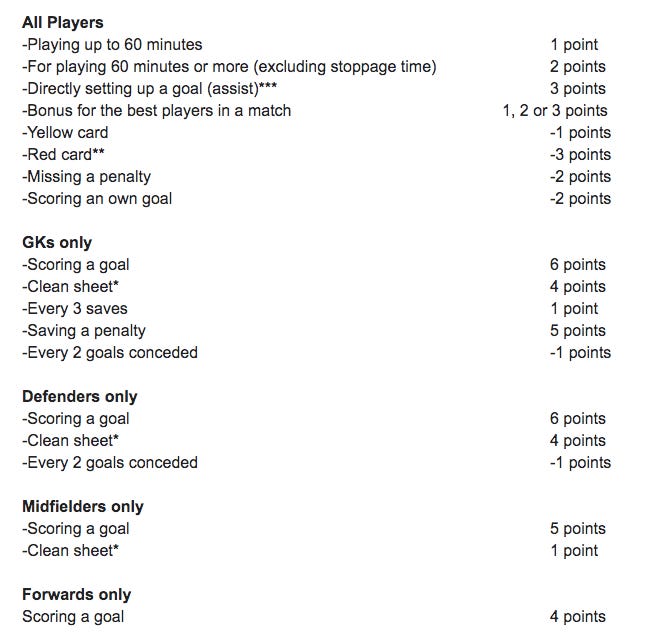A beginner's guide to playing Fantasy Premier League
Learn the basics of the game and get ready to dominate

The rules of the game can be found in full here, but here’s the important stuff:
<Choosing Your Squad>
You start with a budget of £100 million, with which you must ‘buy’ 15 players as follows:
· 2 Goalkeepers
· 5 Defenders
· 5 Midfielders
· 3 Forwards
Note that you can’t have more than three players from any one team.
<Picking Your Team>
Each gameweek (GW), you choose 11 players from your squad to play. You need to have exactly 1 goalkeeper, at least 3 defenders and at least 1 forward, but as long as you fulfill those criteria, you can field any formation you want.
If one of your first 11 doesn’t play, a player from your bench will automatically be substituted in. Make sure you place your three outfield benched players in the order of preference (i.e. the player you want to come on as a sub if needed should be first, the second choice second, and the third choice third). The formation rules (1 goalkeeper, at least 3 defenders and at least 1 forward) still apply however, so if you select, for example, three defenders in your first 11 and one doesn’t play, the automatic substitute will be a defender, even if he’s not in the first bench slot.
<Captain & Vice-Captain>

Each week, you must select one player (the player who you think will get the highest score that week) to be your captain (C). This means that player’s score will be doubled. You must also select a vice-captain (VC). If your captain doesn’t play, then your VC’s score will be doubled instead. If neither your C or VC plays, then you get no double points. Tough luck, sucks to be you.
<Transfers>
Transfers are the lifeblood of the game, and chances are you’ll be making a lot of them (in fact, probably too many) during the season. Regardless of when you select your first squad, you can make unlimited changes (transfers) for free before the GW1 deadline. After that, you get one free transfer per GW. If you don’t use your free transfer in any given GW, it rolls over to the following GW, so you can make two free transfers the following GW. Woop! Unfortunately you can’t roll over more than one free transfer, so two free transfers is the most you can have at any time (without using wildcards or chips, which you don’t need to worry about for now).
If you want to make more transfers, it’s going to cost you precious points: – 4 points will be deducted from your GW score for every transfer you make beyond your free one or two – so think carefully whether you really need to bring in that player you’ve suddenly decided is a genius pick this week.
<Player Price Rises & Falls>
Once the season is underway, player prices can rise or fall depending on how many managers have transferred that player in or out each GW. It’s rare (but not impossible) for a player’s price to rise or fall by more than 0.1m in any one GW. Once a player’s price has changed on the transfers page, that’s how much they now cost if you want to buy them. Just like in real life, FPL inflation’s a bitch. For players already in your squad, it’s a little more complicated: if a player’s value goes below the price you paid for them, then that becomes the selling price (e.g. if you buy a player for 8m and his price subsequently drops to 7.9m, that’s what you get if you sell him). If a player in your squad increases in value, however, you only get 0.1m profit for every 0.2m his price rises (so if you buy a player for 8m and his value increases to 8.1m, you still only get 8m if you sell him; if his price rises to 8.2m, you get 8.1m if you sell him; if his price rises to 8.3m, you get 8.1m if you sell him; if his price rises to 8.4m, you get 8.2m if you sell him; and so on).
<What You Score Points For>

*Clean sheet points are awarded to a player who plays at least 60 minutes (excluding stoppage time) and doesn’t concede a goal while on the pitch. If a player plays at least 60 minutes without conceding a goal and is substituted, he gets the clean sheet points, even if his team subsequently concedes a goal or goals after he has left the pitch. If a player is red carded, however, they will collect minus points as if they were still on the pitch for goals conceded by their team.
**Red card minus points include any points deducted for yellow cards (i.e. players get a -3 for two yellow cards, not a -1 plus a -3.)
***Assist points are awarded to the player from the goal-scoring team who gets the final touch before a goal is scored, whether intentionally or unintentionally. If a player has a shot on goal that is blocked by an opposition player, saved by the goalkeeper or hits the woodwork, and a goal is scored from the rebound, then the player who took the first shot receives the assist points. A player also gets the assist points if he shoots or passes the ball and an opposition player puts the ball into his own net, or if he is fouled for a penalty or direct free kick that is subsequently scored by a teammate (often known as the ‘fantasy assist’). Players can’t assist themselves, so if a player wins then scores a penalty or direct free kick, no assist points are awarded. Likewise, no assist points are awarded if an opposition player gets a significant touch on the ball after the final pass but before a goal is scored, or if the goal scorer loses and then regains possession between receiving the pass and hitting the back of the net.
So now you know.
–Pablo


